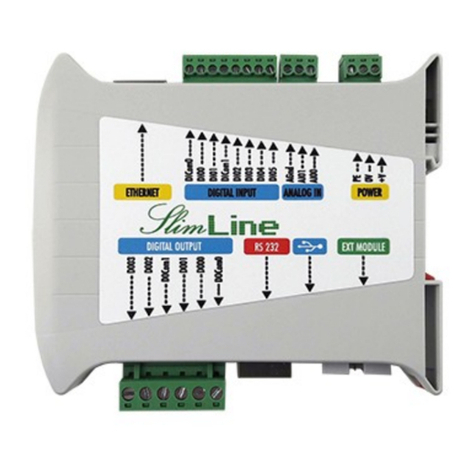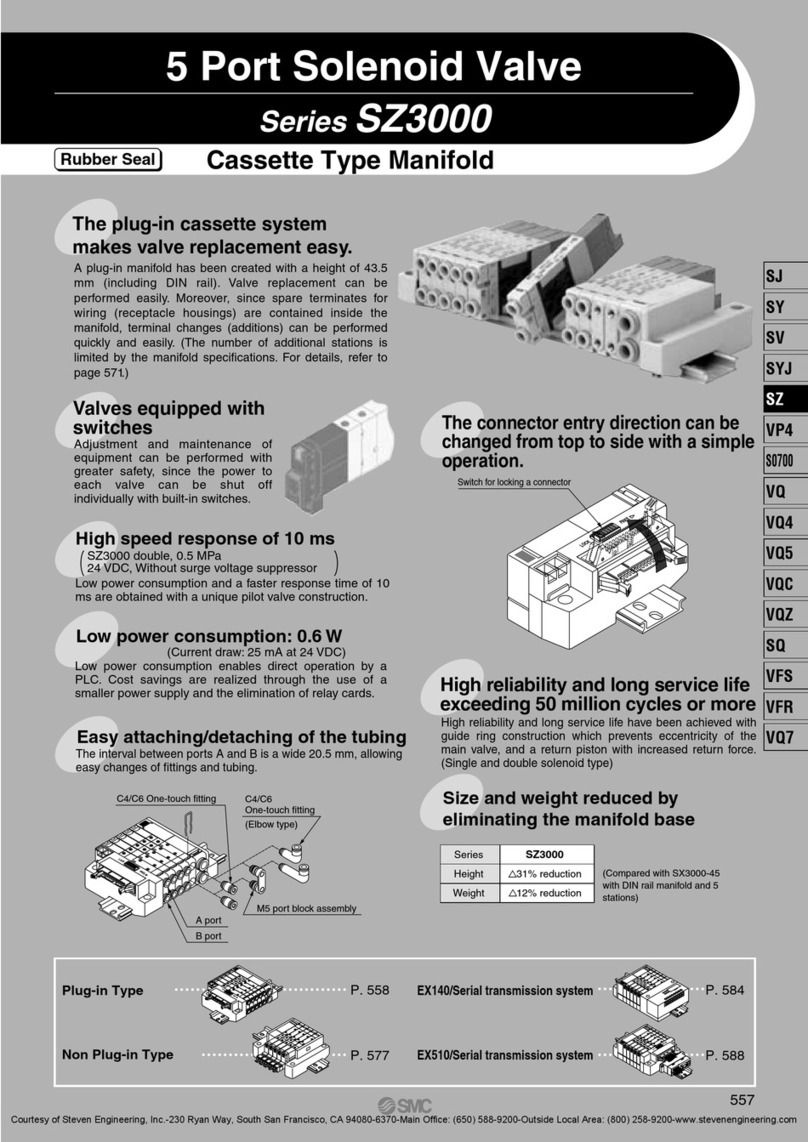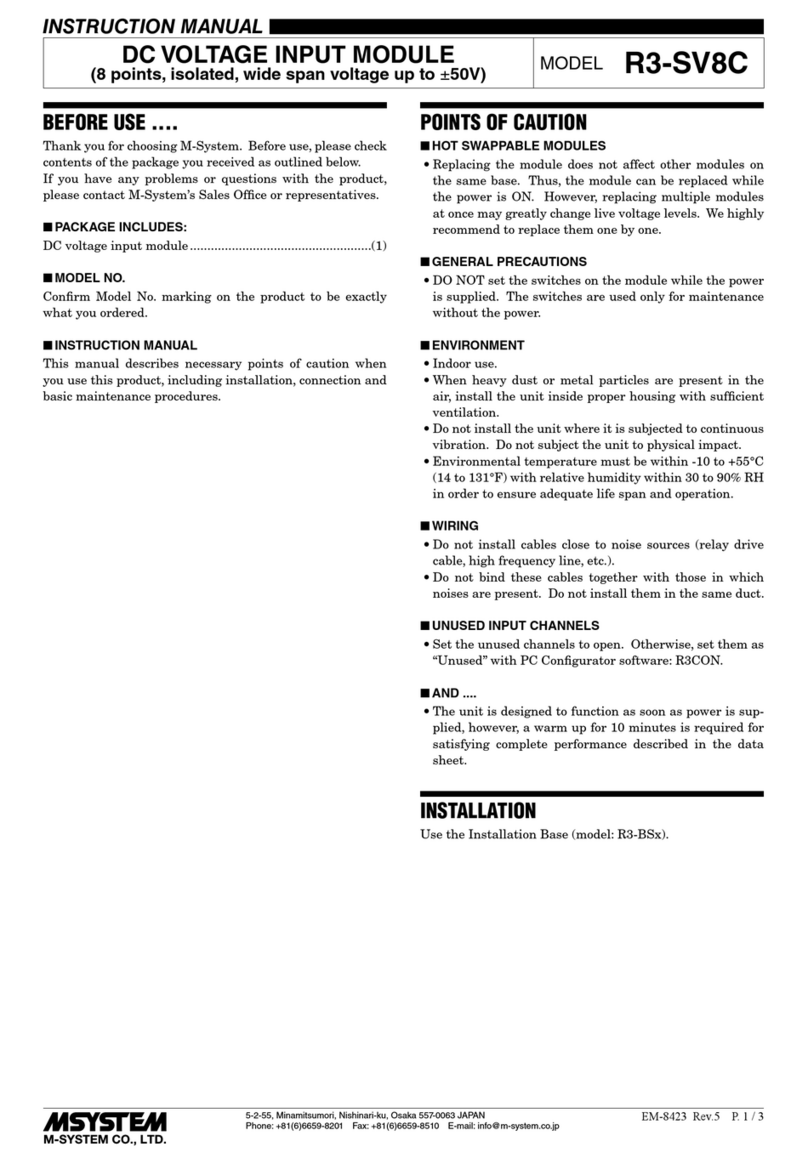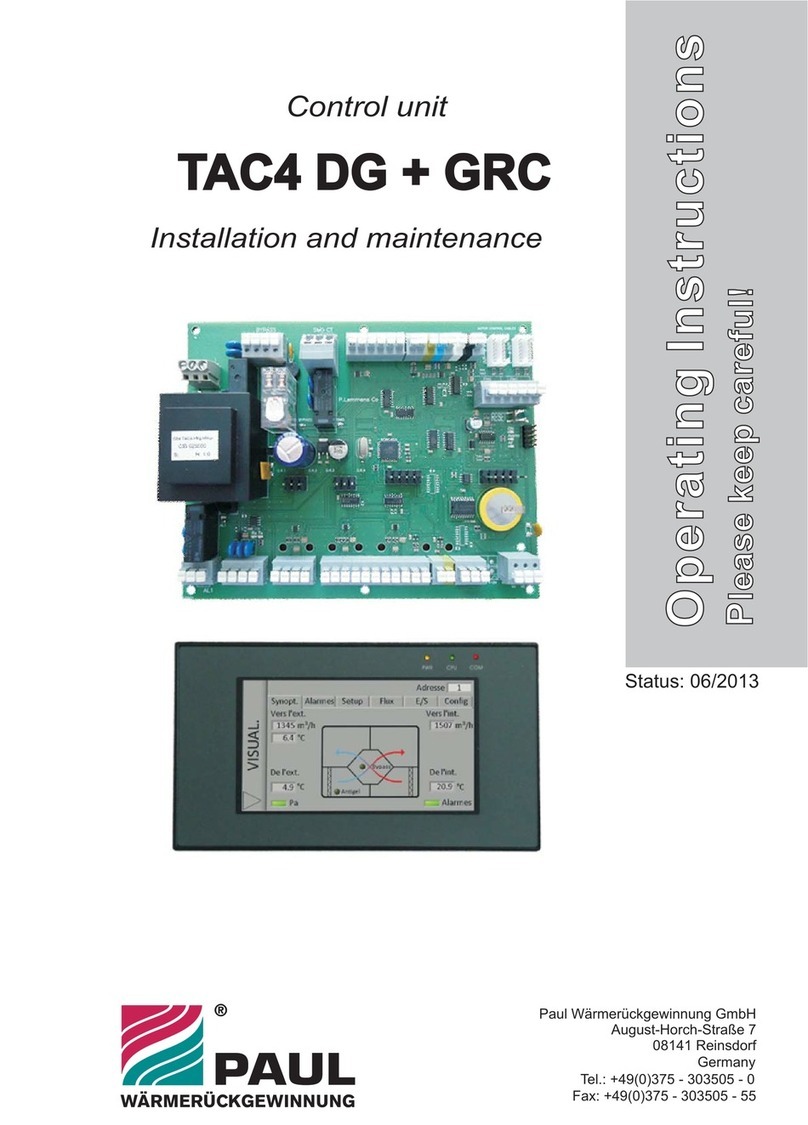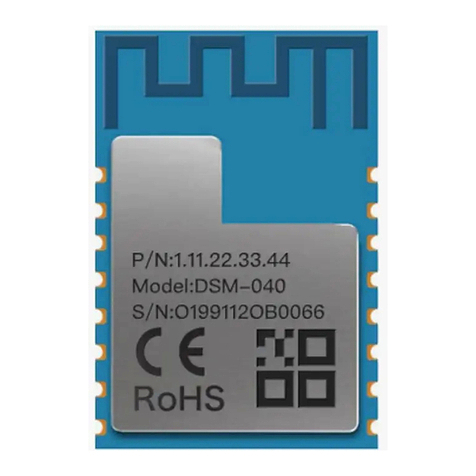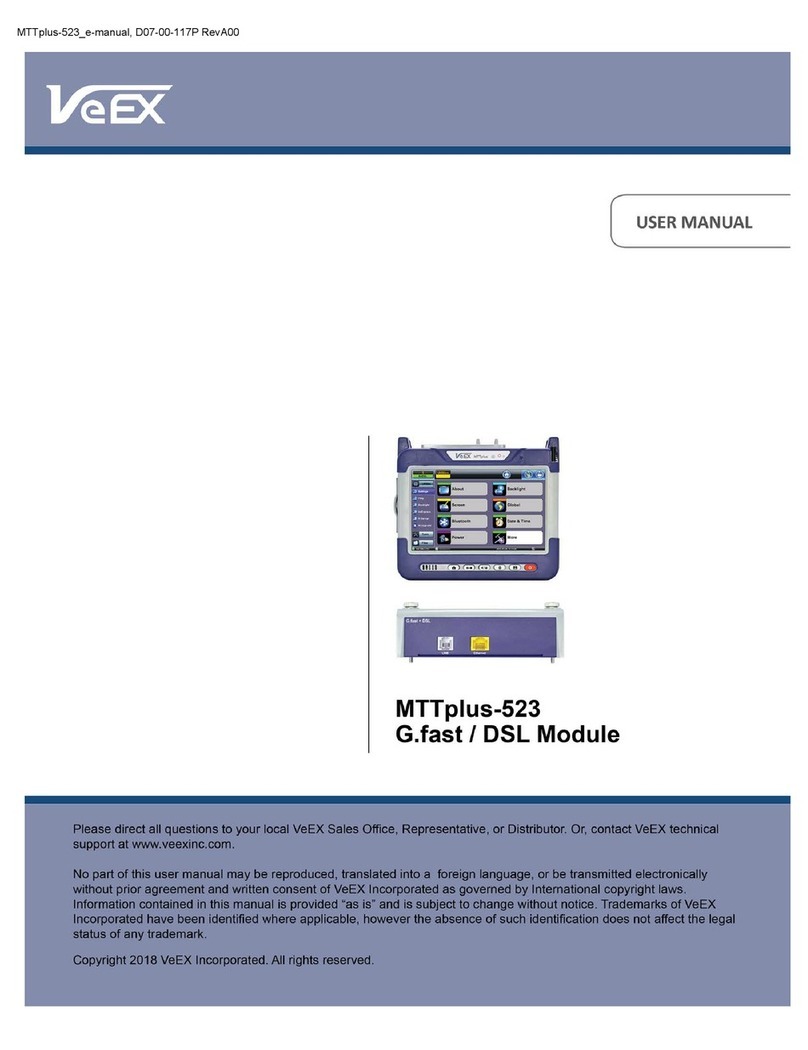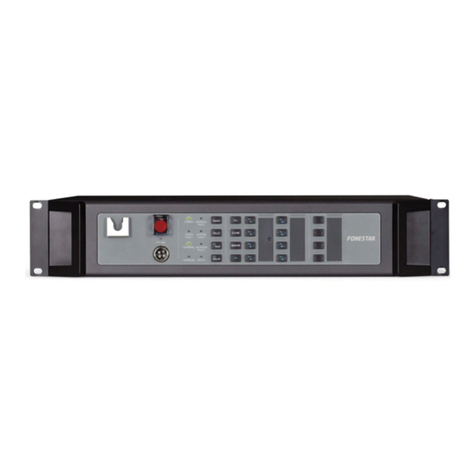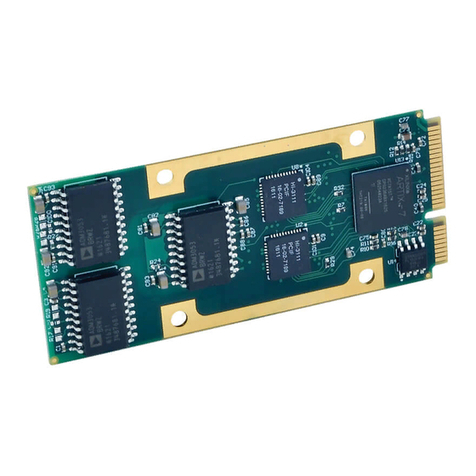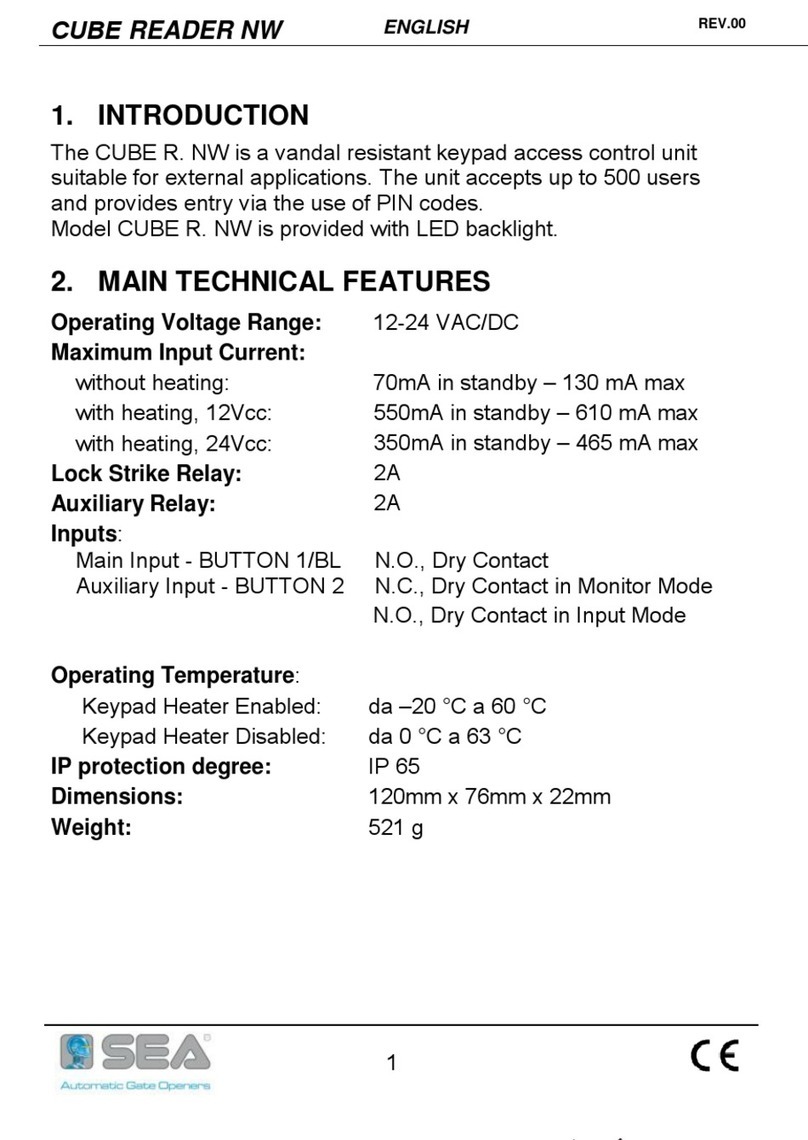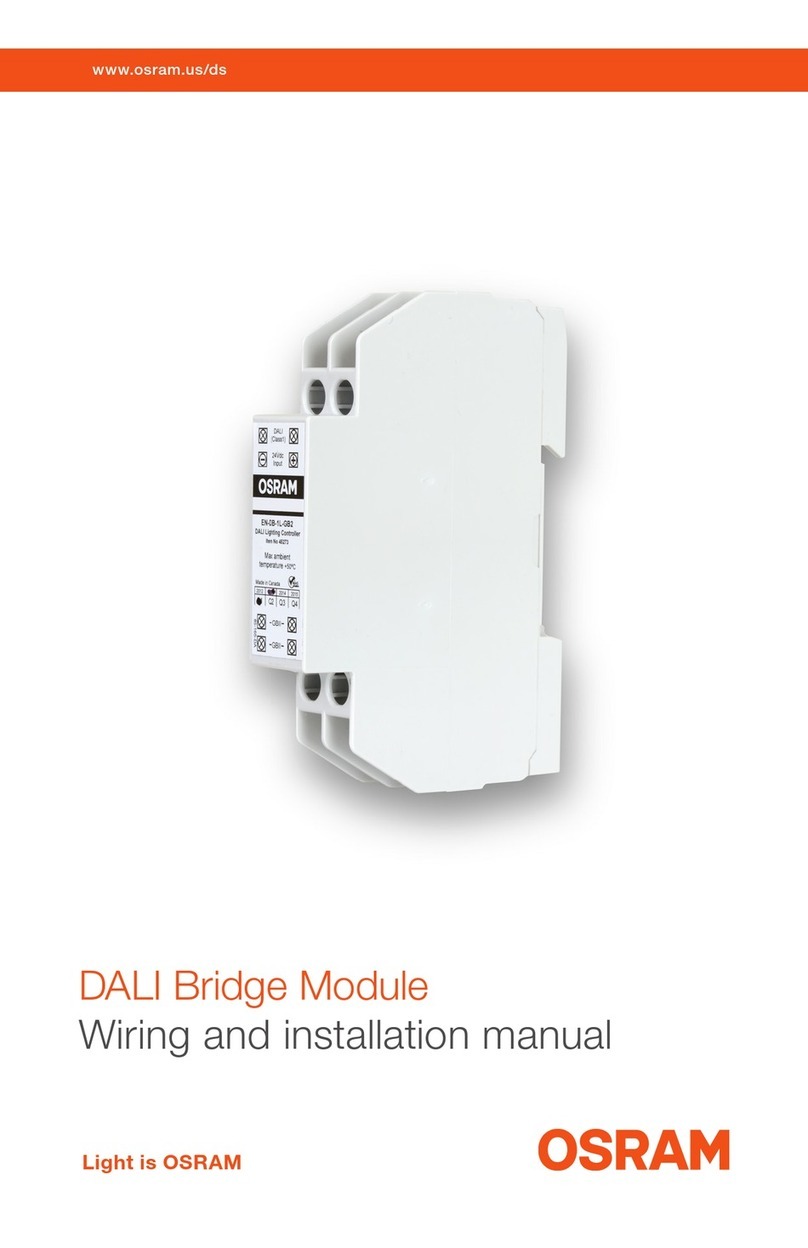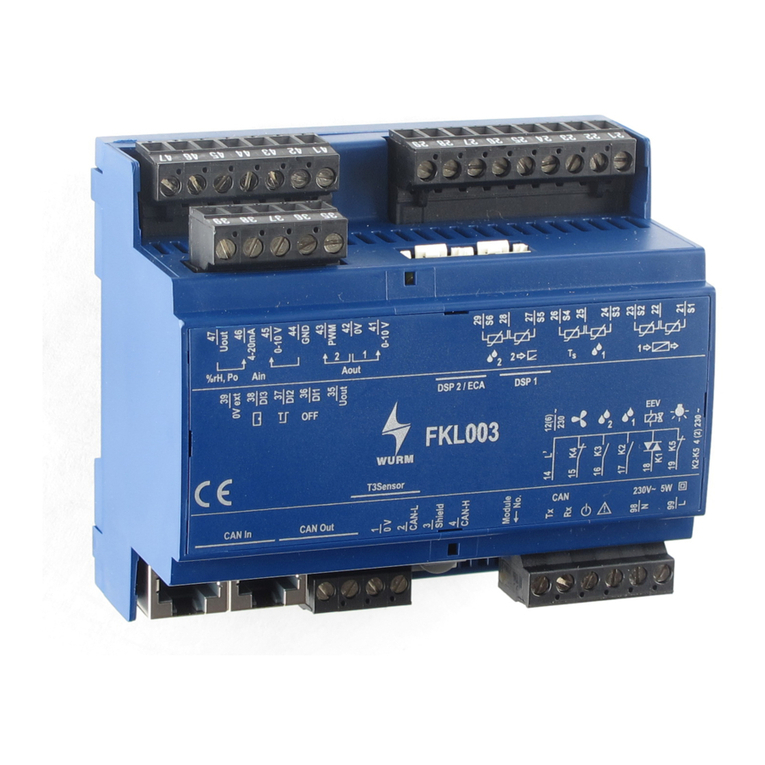SPM BDM-40 User manual

Description
Bearing Display Modules measures the shock pulse values of rolling bearings in dBsv on two channels
and converts the result to analog signals, 4-20 mA. The measuring range can be jumper set on the lower
circuit board to either 0 – 80 dBsv or to 20 – 100 dBsv. Via coaxial cables with TNC connectors, the BDM
modules are connected to shock pulse transducers of type SPM 40000 (BDM-40) or of type SPM 42000
(BDM-42). The modules are supplied with 12 to 24 V DC ±10%, source referred to earth.
The Bearing Display Modules have two relay outputs, 24 V/100 mA. The relays can be controlled by
either input channel. When using one input channel ('r 1' mode), both relays are slaved to that channel
and provide relay switching at two levels (ALERT and ALARM). When using two input channels ('r 2'
mode), each channel uses one relay which switches at the ALARM level.
Measured quantities and ranges are selected from a list of 13 programs. The user can add 7 own
programs. Programmable parameters for each input channel are the measuring range, the two alarm
levels ALERT and ALARM, and the time delay for each. The user also selects the relay mode and either
manual or automatic reset of ALARM. These parameters are input with two push-buttons.
Status display is provided by three coloured LEDs. The green LED is on while measured values are below
the ALERT level. Measured values between ALERT and ALARM on either channel trigger a yellow LED,
and a red LED lights up when a measured value exceeds one of the ALARM levels. A blinking yellow LED
indicates a system fault (incoming signal below 4 mA).
The measured value is displayed with two digits. In 'two channel mode', the status LEDs and the display
alternate between the two channels. The display shows the channel number followed by the measured
value on this channel.
The display modules can be connected to the analog input (4-20 mA analog signals) and the digital input
(relays) of a PLC.
DC supply 12 to 24 V,
source referred to earth
Yellow on = ALERT
Yellow blinking = system fault
Red on = ALARM
Red blinking = ALARM and
system fault
Green on = power on,
no alarm
Value display
Control buttons
Relay 2
Relay 1
Measurement unit
stickers
Channel 1 Channel 2
Jumper for measuring range setting Jumper for TLT OFF
Installation of Bearing Display Modules BDM
SPM Instrument AB • Box 504 • SE-645 25 Strängnäs • Sweden
Technical data are subject to change without notice.
ISO 9001 certified. © SPM 2004-04. 71748.B

Installation of Bearing Display Module BDM
2
Technical data for Bearing Display Module BDM-40 and BDM-42
Measuring method: SPM dBm, unnormalized maximum value
Measuring channels: 2, multiplexing
Measuring range 1: 0 to 80 dBsv (5 dB /mA, 0.2mA/dB)
Measuring range 2: 20 to 100 dBsv (4 mA ≤20 dBsv)
Measuring time: approx. 1 second per channel
Transducer type: SPM 40000 (BDM-40), SPM 42000 (BDM-42)
Transducer cable: coaxial cable, SPM 90005-L, or 90267-L (L = length in m)
Analog output: 4 to 20 mA, no galvanic separation
Fault indication: ≤1 mA out = interrupted or faulty transducer line
Loop resistance: max. 450 Ωat 12 V, 1.1 kΩat 24 V
Power supply: 12 to 24V DC (±10%, tested according to EN 50082-2) source
referred to earth
Supply current: max. 0.15 A
Cable inlet: IP 65 at ø 5.5 to 10 mm
Housing: polycarbonate, IP65
Temperature range: 0 to 55 °C
Vibration exposure: max. 5 mm/s RMS
Dimensions: 110 x 149 x 56 mm
Mounting screws: 4 screws, ø 4 mm, spacing 109 x 94 mm
Weight: 400 g
Signal to display: 4 to 20 mA, 2 channels
Relays: 2, max. 24 V/100 mA
Value display: 3 digits LED
Condition display: green, yellow, and red LED
Alarm limits: 2 per input channel, set with push-buttons
Push-buttons: 2, for display control and settings
56
124
110
109
94
149
Coaxial cable with
TNC connectors Shock pulse transducer
Module Transducer Cable length
BDM-40 40000 max. 4 m
BDM-42 42000 max. 100 m

3
Installation of Bearing Display Module BDM
The analog signals 4 - 20 mA can also be used in
the AMS unit for on-line condition monitoring in
connection with the SPM Condmaster®Pro soft-
ware.
Note that the max. total loop resistance of a 4-
20 mA circuit depends on the signal source. As a
rule, loop resistance should not exceed 400 Ωin
a CMM system.
Loop resistance R = 47 + 47 + 75 = 169 Ω
+ cable resistance. Maximum 400 Ω
Electrical installation
When used as a stand-alone display unit, the module is connected to a 12 - 24 V DC power source with
earth reference. All electric connections are made to the upper circuit board. The jumpers connecting
the analog channels to earth are factory mounted and can be removed when connecting to a PLC.
BDM modules are delivered with jumpers that connect the 4 - 20 mA output of the lower measuring
circuit to the upper display circuit.
When connected to a PLC, the display module can get its power supply from it. The jumpers from the
analog channels are removed. The analog channels are connected to the PLC's AI (analog in) unit, the
relays to the DI (digital in) unit.
Please note: The return line from the current loop are connected to the negative pole on the power
supply.
Mechanical installation
The module is wall mounted, with 4 screws through the back of the casing. The screw diameter is 4 mm, the
spacing is 109 x 94 mm. The module housing has a transparent lid fixed to the box by four screws and has
to be opened for installation and programming. The maximum vibration exposure is 5 mm/s RMS. The
temperature range is 0 to 55 °C (32 - 130 °F). The incoming signal/power cables must have a diameter of 5.5
to 10 mm to maintain IP65.
Analog
signal
– + PLC
75 Ω
+ –
AMS
47 Ω
+ –
BDM
47 Ω
+ –
4–20 mA
BDM connected to PLC
measuring circuit board
(lower)
BDM
measuring circuit board
(lower)

Installation of Bearing Display Module BDM
4
Measuring
circuit board
BDM modules contain two circuit boards, the bearing measuring circuit board (lower) and the display
circuit board (upper) for 4 – 20 mA analog signals. The analog output(s) on the measuring board are
factory connected to the display board.
All electric connections are made to the upper display circuit board. The lower board has two jumpers,
one is used to select the measuring range and one to select TLT OFF (this jumper is factory mounted on
one of the contact pins).
Measuring range setting
The jumper socket marked 1 2 in the upper left corner on the circuit board is used to set the measuring
range in unnormalized shock values:
1. 0 – 80 dBsv 2. 20 – 100 dBsv
One of these ranges must be selected and have effect on both channels. The factory setting is 0 - 80 dBsv.
The range can be changed at any time. Note that the display range program or the PLC must be changed
accordingly.
TLT OFF (test)
In case of transducer line fault (open or short circuit), the analog signal goes down to <1 mA. To avoid
problems with e.g. a PLC, one can move the jumper to both contact pins at ”TLT OFF” on the circuit
board. This will eliminate the transducer line test and keeps the channel output at min. 4 mA in case of
fault.
0 – 80 dBsv 20 – 100 dBsv
TLT OFF (test)
12
12
A jumper can be set at TLT OFF for test
(min. 4 mA in case of TLT fault)
TLT (normal)
Jumper for setting of measuring range

5
Installation of Bearing Display Module BDM
RPM
RPM
Measuring range 0 to 80 dBsv, alarm level at 35 dBn
Measuring range 20 to 100 dBsv, alarm level at 35 dBn
Shaft
diameter
mm
Shaft
diameter
mm
Alarm levels in relation to bearing seize and speed
The initial shock pulse level (dBi = decibel initial) of rolling bearings in good condition depends on bearing
size and rotational speed. The beginning of the red ”bad condition” zone is normally dBi + 35 dB (35 dBn on
the normalized scale). In the diagrams, this level is shown in dBsv (unnormalized shock value) and in mA.
Example:
A bearing with shaft diameter d = 20 mm and rotational speed = 1100 rpm has a dBi of 10. 35 dBn thus
corresponds to 45 dBsv, that is 13 mA for measuring range 0 to 80 dBsv, and 9 mA for measuring range 20 to
100 dBsv.
As signal strength also depends on the quality of the measuring point, it may be necessary to adjust the alarm
level to the individual bearing, normally downwards.
Whenever possible, the bearing should be measured with a SPM Tester before setting alarm levels. This
instrument will also show the exact initial value dBi of a bearing when shaft diameter and rpm are input.

Installation of Bearing Display Module BDM
6
No. Quantity Unit 4mA 20mA
00 Test 0-20 mA mA 4.0 20.0
01 Vibration mm/s 0.0 5.0
02 Vibration mm/s 0.0 10.0
03 Vibration mm/s 0.0 20.0
04 Vibration mm/s 0.0 40.0
05 Shock pulse dBsv 0 80
06 Shock pulse dBsv 20 100
07 Temperature °C-16 120
08 Vibration inch/s 0.00 0.19
09 Vibration inch/s 0.0 0.39
10 Vibration inch/s 0.0 0.78
No. Quantity Unit 4mA 20mA
11 Vibration inch/s 0.0 1.57
12 Temperature °F3248
13 Percentage % 0 100
14
15
16
17
18
19
20
( Free configuration of programs 14 - 20 )
Display during operation
In 'one channel mode', the number display shows the
value on channel 1. The LEDs show the status:
Level 2 ALARM red
Level 1 ALERT yellow
Signal < 4 mA flashing yellow (not program 00)
OK green.
Channel and active program
3seconds
One channel mode
Two channel mode
Active program
3seconds
One channel mode
Two channel mode
To check the active program(s), hold down A+B until all
LEDs light up and the number display flashes. The display
shows one digit for measuring mode/channel followed by
two digits for the active program:
0XX One channel mode, program no. XX
1XX Two channel mode, program no. XX on channel 1
2XX Two channel mode, program no. XX on channel 2.
The module returns to the measuring mode after 30
seconds.
The 'one channel mode' can be programmed for channel 1 even when both channels are receiving input
signals. In this case, no results for channel 2 will be shown until the mode is changed. It is not possible to
measure on channel 2 only. If channel 1 is disconnected while the module is active, there will be a
continuous 'interrupted circuit' status (flashing yellow LED, outgoing analog signal ≈0 mA). Please note
that this does not apply to program 00, which is a test function showing the actual input current.
If an alarm delay cycle is interrupted by a measured value below the alarm limit, it starts again from 0
when the next value above the alarm limit is received.
Measuring programs
Programs 05 (0 – 80 dBsv) and 06 (20 – 100 dBsv) are used for shock pulse measuring and should
correspond to the measuring range set by the jumper on the lower measuring circuit board.
In 'two channel mode', the display alternates between the channels, showing CH1 – value, then CH2 –
value. The alarm status for the active channel is shown by the LEDs as in 'one channel mode'.

7
Installation of Bearing Display Module BDM
1. Hold down A+B until all LEDs light up. The
display shows the active program(s).
2. Hold down A+B until the display flashes
”000”.
3. Press A for 'one channel mode'. The display
shows ”0XX”, where the flashing "XX" is the
number of the active program.
4. To change the program, press B repeatedly
until the desired program number is shown.
5. Press A to go to the reset setting. B toggles
between automatic and manual reset (see
below).
6. Press A to end the programming mode and
start normal operation.
3seconds
Selects program
Programming, one channel mode
Shows active program(s)
Starts programming mode
Sets 'One channel mode',
shows active program
One channel mode, programming
When programming in 'one channel mode', the button A is used to go to the next step while the button
B is used to make changes. You can step through the whole program and check all setting by simply
pressing A.
3seconds
Shows reset setting
Ends programming mode
Toggles between AAU
(automatic reset) and Art
(manual reset) of ALARM
Alarm reset
ALERT (yellow LED on) always has automatic reset: both the status display and relay positions are
controlled by the measured signal. This means that an alarm disappears when the measured value drops
to or below the alarm limit.
ALARM (red LED on) has the same automatic reset when 'AAU' is active. When manual reset 'Art' is
active, the status display and the relay positions are held until either A or B is pushed. This will reset the
status display and the relays if the alarm condition has disappeared.
Please note: if the incoming signal drops below 4 mA while ALARM is held, the red LED will flash instead
of the yellow LED.
Relay action in one channel mode
The relays are specified 24 V/100 mA. In one channel mode, the relay mode 'r 1' is active and can not be
changed by the user.
ALARM
red LED on
ALERT (no power)
yellow LED on
OK
green LED on
In one channel mode, the module receives the analog
signal on channel 1. Two alarm levels can be programmed
(see page 8).
Level 1 = ALERT = yellow LED is connected to Relay 1.
Relay 1 is NC = normally closed. It opens on power
failure and on alarm (value above the lower or ALERT
alarm level). Thus, it will be open when the yellow or the
red status LED is on.
Level 2 = ALARM = red LED is connected to Relay 2.
Relay 2 is NO = normally open. It closes on ALARM =
red status LED is on. NC NO

Installation of Bearing Display Module BDM
8
1. Hold down A+B until all LEDs light up. The
display shows the active program(s).
2. Hold down A+B until the display flashes
”000”.
3. Press B for 'two channel mode'. The display
shows ”1XX”, where 1 is the channel and
the flashing "XX" is the number of the active
program.
4. To change the program, press B repeatedly
until the desired program number is shown.
5. Press A to go to channel 2. The display
shows ”2XX”, where 2 is the channel and
the flashing "XX" is the number of the active
program.
6. To change the program, press B repeatedly
until the desired program number is shown.
7. Press A to go to the relay action setting (see
next page). B toggles between NO and NC.
8. Press A to go to the relay mode setting (see
next page). B toggles between 'r 1' and 'r 2'
mode.
9. Press A to go to the reset setting (see
below). B toggles between automatic and
manual reset.
10 Press A to end the programming mode and
start normal operation.
Two channel mode, programming
When programming, the point [ B ] is where you set 'two channel mode'. After that, the button A is used
to go to the next step while the button B is used to make changes. You can step through the rest of
program and check all setting by simply pressing A.
3seconds
Selects program, chan. 1
Programming, two channel mode
Shows active channels
and programs
Starts programming mode
Sets 'Two channel mode',
shows program on chan. 1
3seconds
Shows relay mode 1/2
Ends programming mode
Toggles between relay
mode 1 and relay mode 2
Selects program, chan. 2
Shows program on chan. 2
Shows relay action NO/NC
Toggles between NO
(normally open) and NC
(normally closed)
Shows reset setting
Toggles between AAU
(automatic reset) and Art
(manual reset) of ALARM
Alarm reset
ALERT (yellow LED on) always has automatic reset: both the status display and relay positions are
controlled by the measured signal. This means that an alarm disappears when the measured value drops
to or below the alarm limit.
ALARM (red LED on) has the same automatic reset when 'AAU' is active. When manual reset 'Art' is
active, the status display and the relay positions are held until either A or B is pushed. This will reset the
status display and the relays if the alarm condition has disappeared. Pushing A or B also starts
continuous measurement for 30 seconds on channel 1 (A) or channel 2 (B).
Please note: if the incoming signal drops below 4 mA while ALARM is held, the red LED will flash instead
of the yellow LED when the channel status is shown. Thus, you can have a situation where the loss of
incoming signal on both channels is show by flashing red on one channel and by flashing yellow on the
other (which has no latched alarm).

9
Installation of Bearing Display Module BDM
Relay action in two channel mode
The relays are specified 24 V/100 mA. In 'two channel mode', the user can select one of three alternative
relay modes.
ALARM
red LED on
ALERT (no power)
yellow LED on
OK
green LED on
Relay mode 'r 1'
In two channel mode, the module receives analog signals on both channel 1 and channel 2. Two alarm
levels can be programmed for each channel (see page 8). Relay mode 'r 1' implies, that both relays are
slaved to the channel with the higher alarm status.
The mode is set by selecting 'r 1' when programming.
This overrides the NC/NO setting in the program.
Level 1 = ALERT = yellow LED is connected to Relay 1.
Relay 1 is NC = normally closed. It opens on power
failure and on alarm (value above the lower or ALERT
alarm level). Thus, it will be open when the yellow or
the red status LED is on.
The alarm level 2 = ALARM = red LED is connected to
Relay 2. Relay 2 is NO = normally open. It closes on
ALARM = red status LED is on.
Relay mode 'r 2'
Relay mode 'r 2' implies, that relay 1 is slaved to channel 1 and relay 2 is slaved to
channel 2. The relays act on ALARM = red status LED is on. Thus there is no relay action
on power failure or yellow ALERT.
Relay action is program selected and set to either NO or NC. Thus, there are two alternatives:
ALARM channel 1 + 2
red LED on
ALARM channel 1
red LED on
ALARM channel 2
red LED on
OK / ALERT
green LED on
Mode 'r 2' + 'rn0'
NO (normally open)
ALARM channel 1 + 2
red LED on
ALARM channel 1
red LED on
ALARM channel 2
red LED on
OK / ALERT
green LED on
Mode 'r 2' + 'rnC'
NC (normally closed)
NO NO NC NC
NC NO

Installation of Bearing Display Module BDM
10
Increases
value
2 channel
Increases
value
(3 s)
(3 s)
(3 s)
1 channel
Increases
value
Increases
value
Ends programming
Alarm level 1
ALERT
Value
Alarm level 2
ALARM
Value
Alarm delay
ALERT
Delay in seconds
Alarm delay
ALARM
Delay in seconds
Setting alarm levels and delay
1. For channel 1, hold down button A until
either ”AL1” or ”Ch1” is displayed. For
channel 2, hold down button B until
”Ch2” is displayed. From there, the steps
are the same for both channels:
2. Keep pressing A until you reach the
parameter you want to change.
3. Change the (flashing) parameter value
with button B, then confirm and continue
with A.
If you overstep the desired number setting
with button B, you have to start over again
from the beginning. Pressing A while holding
down B takes you straight to the max. value.
By selecting a measuring program from the
list, you automatically adjust the display of
the module to the pre-programmed range.
The alarm level values are input in the pre-
programmed measuring unit (i. e. not in mA
except for the test program 00). The measur-
ing unit itself is not shown, so it should be
written on the channel label.
The module is back in measuring mode when
you finish programming with A. If you do not
press any button for 30 seconds, the unit will
automatically return to its normal operating
mode. All values confirmed with A will be
saved.

11
Installation of Bearing Display Module BDM
Own program (14-20)
Sets program number 14 – 20
3seconds
3seconds
Increases value at 20 mA
3seconds
Displayed value
at 20 mA
Displayed value
at 4 mA
Increases value at 4 mA
Sets decimal point position
Ends programming mode
• Positive value: jumps to max.
• Value 0: toggles between +and –
• Negative value: jumps to min.
Starts programming mode
• Positive value: jumps to max.
• Value 0: toggles between +and –
• Negative value: jumps to min.
Own programs
You can make programs for any type of meas-
ured quantity with a measuring range of –99 to
999 and represented by the incoming analog
signal. You set
•Program number 14 to 20
•Display format (max. 3 digits, 0 to 2
decimals.
•Measured value represented by 20 mA.
• Measured value represented by 4 mA.
If you overstep the desired number setting with
button B, you have to start over again from the
beginning. For any value on the display other
than 0, pressing A while you hold down B takes
you straight to the max. value.
To set negative values, use button B to set the
display to 0, then change from + to – by press-
ing A while holding down B.
1. Hold down A+B until all LEDs light up. The
display shows the active program(s).
2. Hold down A+B until the display flashes
”000”.
3. Hold down A+B until the display shows a
program number (flashing).
4. Press B repeatedly until the desired
program number (14 - 20) is shown.
5. Press A to go to the decimal point setting.
B moves from none to one to two decimal
places.
6. Press A to go to the value represented by
20 mA. B increases value.
7. Press A to go to the value represented by 4
mA. B increases value.
8. Press A to exit the programming mode.
Program number
Decimal
point
3seconds
3seconds
To select the program, go to programming "One
channel mode" (see page 7) or "Two channel
mode" (see page 8).

__________________________________________________________________________________________________________________________________________________
__________________________________________________________________________________________________________________________________________________
__________________________________________________________________________________________________________________________________________________
__________________________________________________________________________________________________________________________________________________
__________________________________________________________________________________________________________________________________________________
__________________________________________________________________________________________________________________________________________________
__________________________________________________________________________________________________________________________________________________
__________________________________________________________________________________________________________________________________________________
Programming form
Program number
Measuring range and unit
Relay (NO/NC)
Relay mode (1 or 2)
Reset (automatic or manual)
ALERT level (AL1)
ALERT delay (dL1), seconds
ALARM level (AL2)
ALARM delay (dL2), seconds
Settings Channel 1 Channel 2
BDM type: .......................... Serial no.: ................................. Date: ............................. Sign.: ........................
Location: ..................................................................................................................................................................................
Measuring point, channel 1:.............................................................................................................................................
.....................................................................................................................................................................................................
Measuring point, channel 2:.............................................................................................................................................
.....................................................................................................................................................................................................
Machine data: ........................................................................................................................................................................
Comments:..............................................................................................................................................................................
.....................................................................................................................................................................................................
.....................................................................................................................................................................................................
.....................................................................................................................................................................................................
SPM Instrument AB • Box 504 • SE-645 25 Strängnäs • Sweden. Tel +46 152 22500 • Fax +46 152 15075 • [email protected] • www.spminstrument.com
Installation of Bearing Display Module BDM
This manual suits for next models
1
Table of contents
Popular Control Unit manuals by other brands
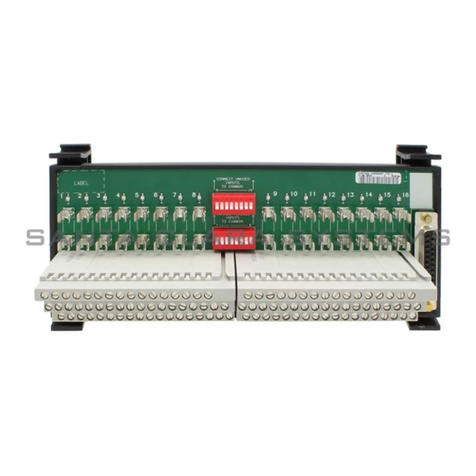
Allen-Bradley
Allen-Bradley 1492-AIFM16-F-5 manual
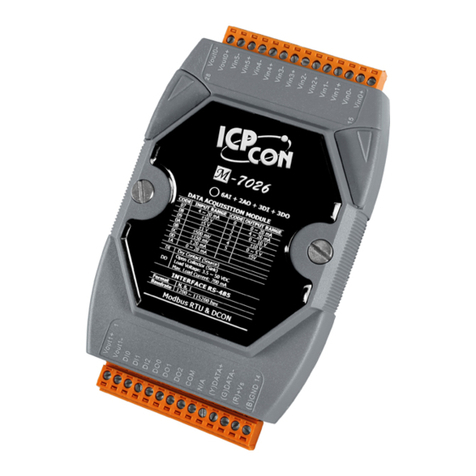
ICP DAS USA
ICP DAS USA M-7026 quick start guide

ICP DAS USA
ICP DAS USA LP-8 21 Series quick start
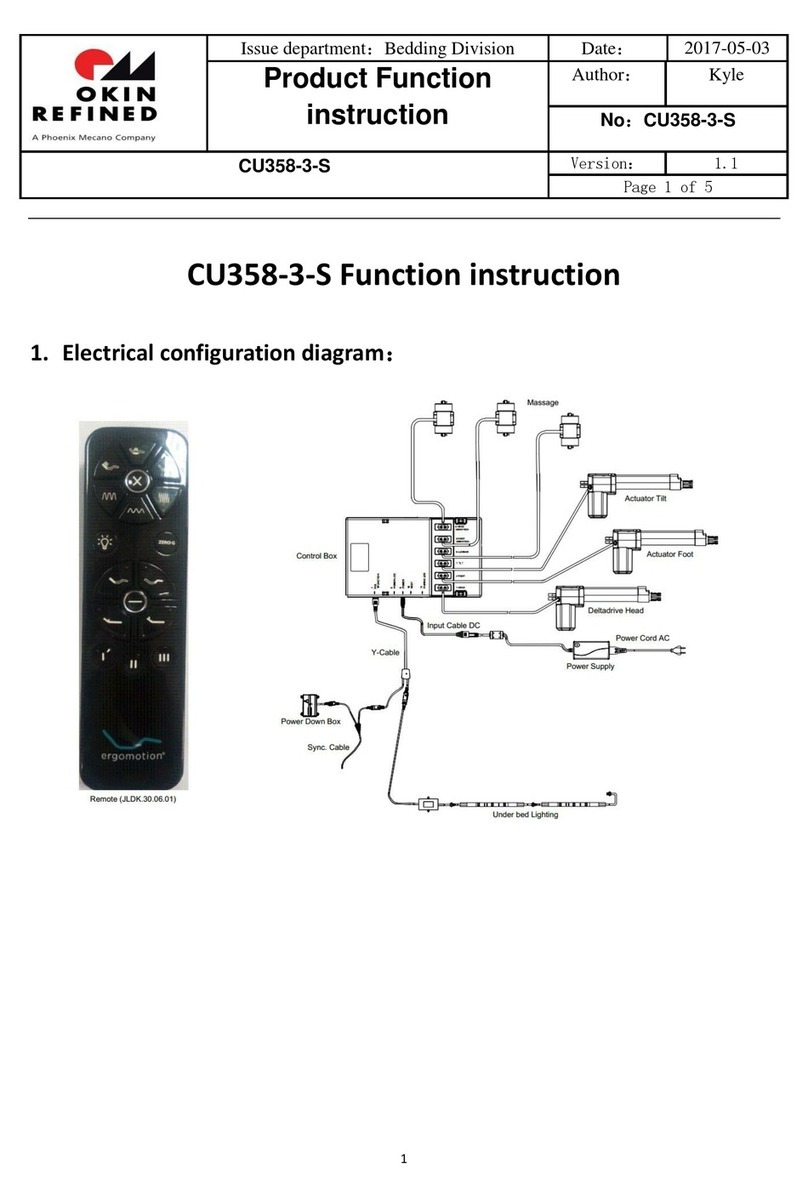
Phoenic Mecano
Phoenic Mecano Okin Q28-BNC quick start guide

Allen-Bradley
Allen-Bradley 1771-OFE installation instructions
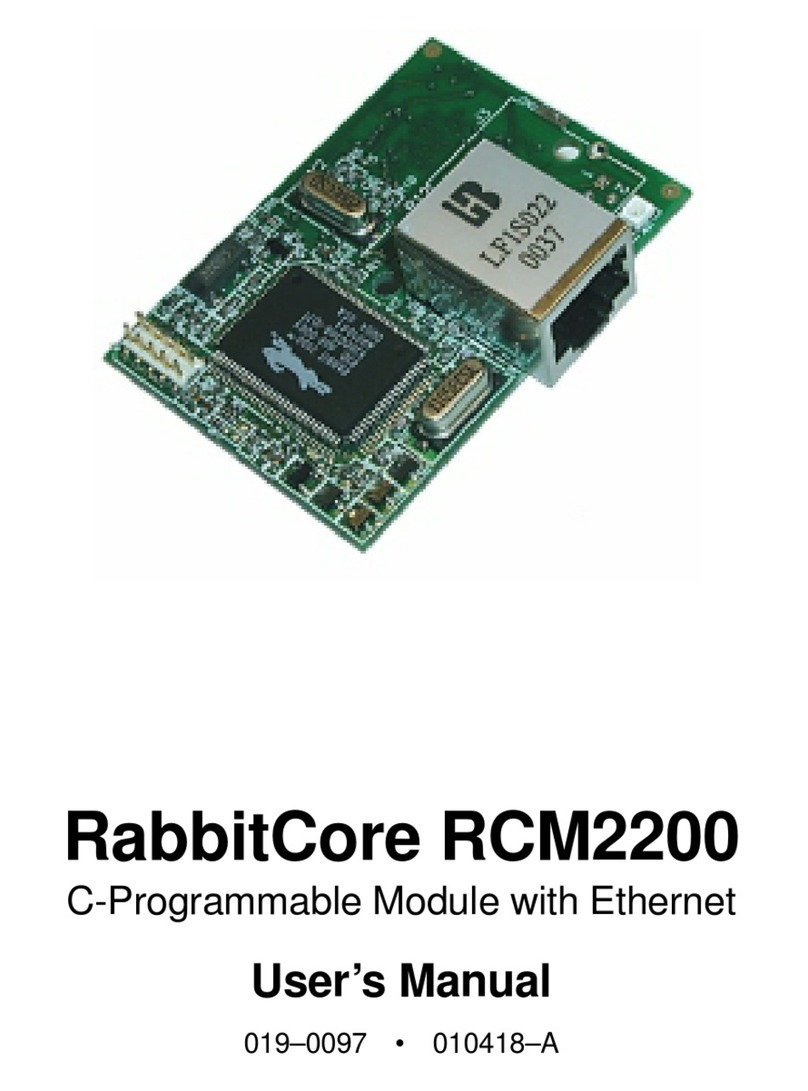
RabbitCore
RabbitCore RCM2200 user manual
